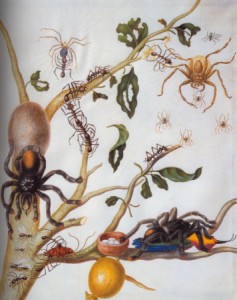READY TO GET STARTED?
REQUEST A FREE ESTIMATE
Fill out the form below or call (888) 466-7849 for a free, no-obligation estimate.
When you reflect on famous artists and their work, like the Mona Lisa by DaVinci for instance, you can immediately appreciate the beauty of their masterpiece. However, when the subject of an artwork is an insect, you might have a little more trouble seeing the beauty in it before wanting to call an exterminator! The brave souls who did make insects their muse had an appreciation for natural history, especially during the 17th century.
Studying bugs for their connection to the earth and nature led to some beautiful creations by Albrecht Dürer such as the Stag Beetle. Dürer said of art, “It is indeed true that art is omnipresent in nature, and the true artist is he who can bring it out.”
Some artists liked to focus on butterflies because they represented transformation and resurrection. Wenceslaus Hollar’s drawing Forty-One Insects, Moths and Butterflies features a collection of bugs of different varieties on displaying much like a “cabinet of curiosity.” Check out this painting and more below!

Maria Sibyla Merian, Branch of guava tree with leafcutter ants, army ants, pink-toed tarantulas, c. 1701-5
Melissa Brown
[email protected]
Source:
http://venetianred.net/2010/04/20/the-busy-bee-has-no-time-for-sorrow-insects-in-art/

The NPMA recently posted an article on their website that explained the dangers that rodents can cause to your home and your health. We often talk in our blogs about the unsanitary conditions and the property damage that a rodent infestation can lead to but we rarely discuss the health risks that are involved.
Rodents, such as mice and rats, can leave droppings that can spread bacteria, contaminate food, and cause allergic reactions. Droppings can also spread diseases and viruses such as the following:
To read the full article or get more information on the diseases above click HERE.
Please don’t take chances with the health of you or your loved ones. If you have rodents in your home, call a licensed exterminator, Northwest Exterminating, to get rid of the rodents in your home.
Source: http://www.pestworld.org/news-and-views/pest-articles/articles/health-threats-posed-by-rodents/
Baking is a big part of tradition for lots of people during the holiday season. And what better time while you’re breaking out all of the baking supplies to inspect your pantry for signs of pests. Pests are living creatures that are in search of the same things we are…food, water, and shelter. A pantry where those necessities are stored is an ideal place for pests to make a home.
Common pests that are found in pantries:
Below are tips on ways to inspect your pantry for pests:
If you find pests in your pantry, throw out the infested food immediately. If pests have made a home in your pantry you should call your professional pest control company. A professional exterminator will be able to inspect the area and treat the problem properly and efficiently.
Sources:
http://www.pestworld.org/news-and-views/pest-articles/articles/preventing-pantry-pests/
http://lancaster.unl.edu/pest/resources/pantrypests304.shtml
Though having pests in your home may be a different story, books about bugs have always been favorite reads for children. Below is a list of fictional stories about bugs that your kids are sure to enjoy:
This picture book features the tale of a caterpillar’s metamorphosis into a butterfly accompanied by vivid colored pictures. Children will not only learn about caterpillars, but also about numbers, healthy eating and days of the week as they chronicle his journey from newborn to cocoon.
Ever wonder what ants are up to when they invade your home? Before you call the exterminator, let this picture book give you a glimpse into the mischievous adventures of two ants. Children will learn the importance of following directions and the consequences of their choices.
This classic of children’s literature features a fun-filled cast of characters starting with a young orphan named James. With the help of a magic potion, James causes a peach tree to blossom an abnormally large fruit, which becomes home to an assortment of interesting insects. This perfect first chapter book will offer your children lessons of friendship, bravery and loyalty.
This American classic comes from the author of another well-known tale, Stuart Little. Told from the perspective of a pig, this novel follows the life of barn house creatures, one of which is a spider named Charlotte. Charlotte offers Wilbur much wisdom in one of the most beautiful friendships ever written.
This story follows a cricket from Connecticut who boards the wrong train to Times Square in New York. There he meets many interesting characters, both human and animal, that teach him many lessons, including how to play classical music.
Melissa Brown
[email protected]
 So long are the days of only having to worry that your kids may get head lice in school…you can now add bed bugs to that list. You’ve heard about the risk of bed bugs when returning back to college but now bed bugs are popping up in elementary, middle, and high schools.
So long are the days of only having to worry that your kids may get head lice in school…you can now add bed bugs to that list. You’ve heard about the risk of bed bugs when returning back to college but now bed bugs are popping up in elementary, middle, and high schools.
Bed bugs are making their way into schools through back packs. And while they can’t be transferred from person to person, they can be transferred from back pack to back pack.
The good news is that bed bugs are NOT a sanitation issue and they do not carry diseases. Bed bugs are not a sign of a dirty home but they are very difficult to get rid of.
If you are notified that there may be a chance that your child’s back pack has been infested do not panic…there are things you can do to ensure that they are not brought into your home.
For more information on bed bugs visit the Georgia Department of Public Heath: http://www.health.state.ga.us/epi/zvbd/infest/index.asp